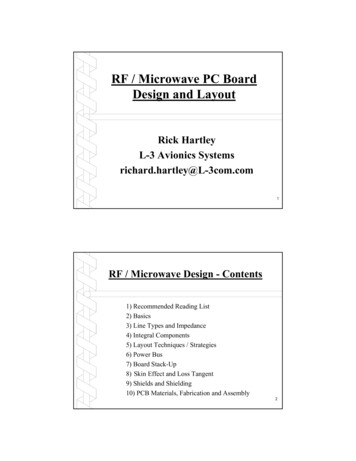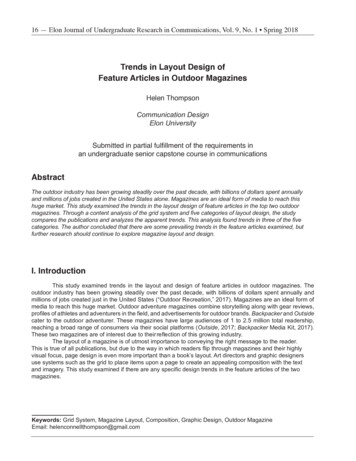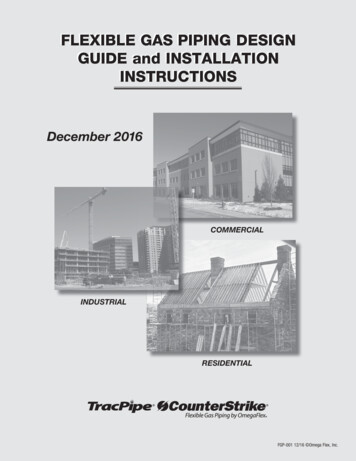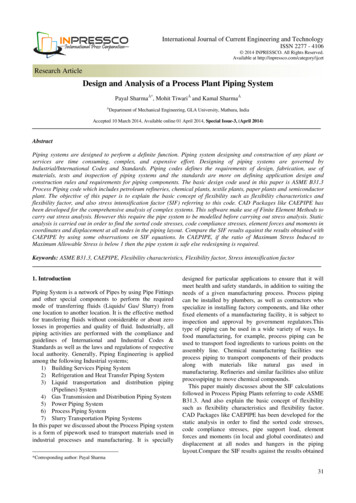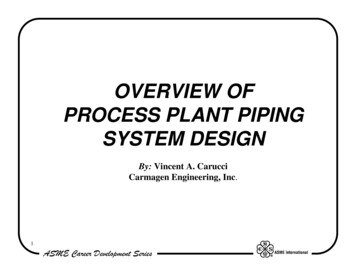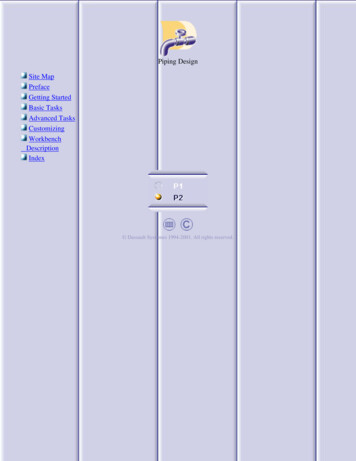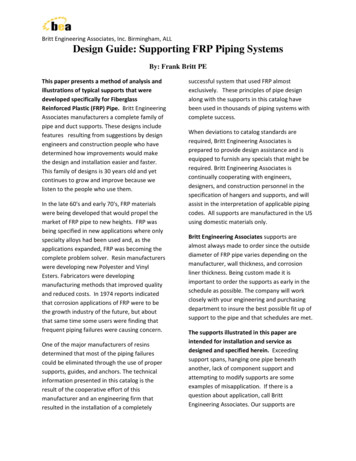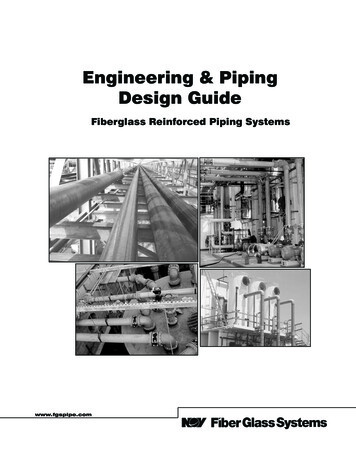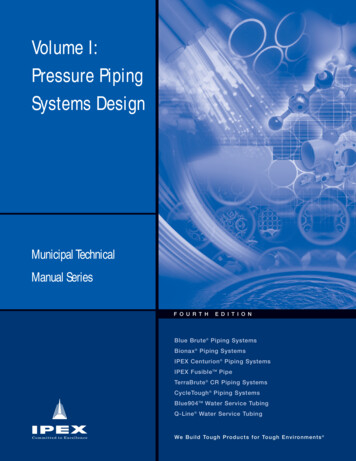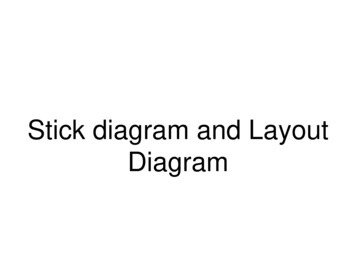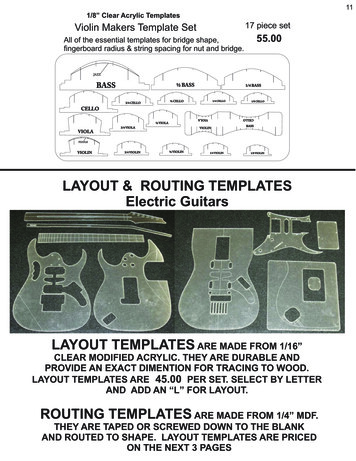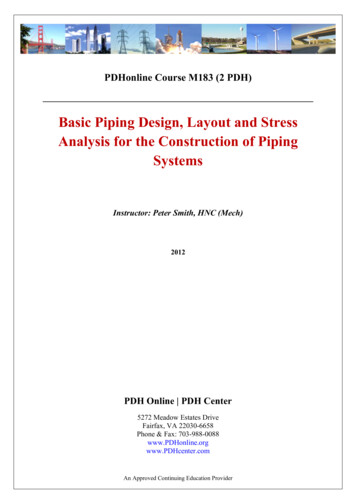
Transcription
PDHonline Course M183 (2 PDH)Basic Piping Design, Layout and StressAnalysis for the Construction of PipingSystemsInstructor: Peter Smith, HNC (Mech)2012PDH Online PDH Center5272 Meadow Estates DriveFairfax, VA 22030-6658Phone & Fax: 703-988-0088www.PDHonline.orgwww.PDHcenter.comAn Approved Continuing Education Provider
NORSOK STANDARDPIPING DESIGN, LAYOUT AND STRESS ANALYSISL-002Rev. 2, September 1997
Please note that every effort has been made to ensure the accuracy of the NORSOK standardsneither OLF nor TBL or any of their members will assume liability for any use thereof.
Piping design, layout and stress analysisL-002Rev. 2, September 1997CONTENTSFOREWORD21 SCOPE32 NORMATIVE REFERENCES33 DEFINITIONS AND ABBREVIATIONS3.1 Definitions3.2 Abbreviations3344 DESIGN AND LAYOUT4.1 General4.2 Numbering systems4.3 Safety and work environment4.4 Clearance and accessibility4.5 Pipe routing4.6 Valves4.7 Vents, drains and sample connections4.8 Equipment piping4.9 Additional requirements related to piping systems4.10 Fittings4.11 Hook-up piping4.12 Hoses and flexible pipes4.13 Instrumentation44445567711131414145 STRESS ANALYSIS5.1 General5.2 Selection criteria for lines subject to comprehensive stress analysis5.3 Design temperature5.4 Environmental temperature5.5 Design pressure5.6 Vibration5.7 Loads5.8 Bending moment on valves, flanges and mechanical joints5.9 Flexible joints5.10 Cold springing5.11 Spring supports5.12 Loads from piping systems on equipment15151516161616171717171717NORSOK standardPage 1 of 17
Piping design, layout and stress analysisL-002Rev. 2, September 1997FOREWORDNORSOK (The competitive standing of the Norwegian offshore sector) is the industry initiative toadd value, reduce cost and lead time and remove unnecessary activities in offshore fielddevelopments and operations.The NORSOK standards are developed by the Norwegian petroleum industry as a part of theNORSOK initiative and are jointly issued by OLF (The Norwegian Oil Industry Association) andTBL (Federation of Norwegian Engineering Industries). NORSOK standards are administered byNTS (Norwegian Technology Standards Institution).The purpose of this industry standard is to replace the individual oil company specifications for usein existing and future petroleum industry developments, subject to the individual company's reviewand application.The NORSOK standards make extensive references to international standards. Where relevant, thecontents of this standard will be used to provide input to the international standardisation process.Subject to implementation into international standards, this NORSOK standard will be withdrawn.NORSOK standardPage 2 of 17
Piping design, layout and stress analysis1L-002Rev. 2, September 1997SCOPEThis standard covers the basis for design and layout of process, drilling and utility piping foroffshore oil and/or gas production facilities. Relevant parts of this standard may also be used forcontrol room, laboratory, helideck and other facilities around the platform.The standard does not cover the following:1.2.3.4.All instrument control piping downstream of the last piping block valve.Risers and sub-sea pipework.Sanitary piping systems.GRP piping. (See NORSOK standard M-621)2NORMATIVE REFERENCESThe following standards include provisions which, through reference in this text, constituteprovisions of this NORSOK standard. Latest issue of the references shall be used unless otherwiseagreed. Other recognized standards may be used provided it can be shown that they meet or exceedthe requirements of the standards referenced below.NORSOK L-001NORSOK L-003NORSOK P-001NORSOK R-001NORSOK S-001NORSOK S-002NORSOK Z-002Piping and valvesPiping detail (presently L-CR-003)Process designMechanical equipmentTechnical safetyWorking environmentCoding system (presently Z-DP-002)National and international codes and standards:ASME B31.3DNVISO 5167ISO 10420Process Piping.Guidelines for flexible pipesMeasurement of fluid flowFlexible pipe systems for subsea and marine riser applications(based on API RP 17B)3DEFINITIONS AND ABBREVIATIONS3.1CanDefinitionsIsolation ValveNORSOK standardCan requirements are conditional and indicates a possibility open to theuser of the standard.An insulation valve is defined as a valve that is used to shut off a piece ofequipment or system for maintenance purpose only.Page 3 of 17
Piping design, layout and stress analysisMayNormative referencesShallShouldL-002Rev. 2, September 1997May indicates a course of action that is permissible within the limits ofthe standard (a permission).Shall mean normative in the application of NORSOK standardsShall is an absolute requirement which shall be followed strictly in orderto conform with the standard.Should is a recommendation. Alternative solutions having the samefunctionality and quality are acceptable.3.2AbbreviationsThe following abbreviations are given for terms used in this standard:APIASMEDDNVEDSISONPSNPSH4American Petroleum InstituteThe American Society of Mechanical EngineersDiameterDet Norske VeritasElement Data SheetInternational Organization for StandardizationNominal Pipe SizeNet Positive Suction HeadDESIGN AND LAYOUT4.1GeneralThe design of all systems shall be in accordance with latest edition of the codes and standards listedin clause 2 Normative references.Design conditions shall be in accordance with the ASME B31.3. except where the requirements ofthis standard are more stringent.4.2Numbering systemsNumbering systems for piping, piping items and valves shall be in accordance with Z-002.4.3Safety and work environmentErgonomic consideration shall be taken in design regarding: Tools, valves and control devices, including emergency controls devices shall be accessible. Provision for cleaning, maintenance and repair shall be taken into consideration.Requirements related to safety and working environment shall conform with S-002.Potential source of hazard (release of hydrocarbons), e.g. flange joints, shall be located insidehazardous areas as defined in the Area Classification drawings or specification. However, areevaluation of the area classification is still necessary, in order to check for any consequences.(Even if all sources are located inside hazardous area, there might still be a need for extentions).Where applicable, provision shall be made to protect piping and equipment from falling objects.NORSOK standardPage 4 of 17
Piping design, layout and stress analysisL-002Rev. 2, September 19974.4Clearance and accessibilityAll piping shall be arranged to provide specified headroom and clearances for technical safety, easyoperation, inspection, maintenance and dismantling as stated in S-002.Particular attention shall be addressed to clearances required for the removal of pump, compressorand turbine casings and shafts, pump and fan drivers, exchanger bundles, compressor and enginepistons. Piping shall be kept clear of manholes, access openings, inspection points, hatches, davits,overhead cranes, runway beams, clearance areas for instrument removal, tower dropout areas, accessways and emergency escape routes.A vertical clearance of 40 mm is recommended between bottom of skid and deck/floor to facilitatecleaning/maintenance.Pipe, fittings, valve controls, access panels or other equipment shall not extend into escape areas.4.5Pipe routing4.5.1 ArrangementAll piping shall be routed so as to provide a simple, neat and economical layout, allowing for easysupport and adequate flexibility.Piping should be arranged on horizontal racks at specific elevations. When changing direction (fromlongitudinal to transverse or vice versa) the piping should change elevation, but care shall be takento avoid pockets. No piping shall be located inside instrument, electrical or telecommunicationcontrol/switchgear rooms, except fire fighting piping serving these rooms. Bridge piping shall bedesigned with expansion loops capable of handling relative movement of platforms in design stormconditions.4.5.2 GroupingCold and hot piping should be grouped separately with hot, non insulated, lines at a higher elevationthan cold lines. Uninsulated lines with possibility for ice build-up, shall not be run above walkways.When expansion loops are required, lines should be grouped together and located on the outside ofthe rack.Small pipes should be grouped together to simplify support design.4.5.3 LocationLocating small pipes between large pipes shall be avoided especially when the large lines are hot.Heaviest lines should be located furthest from centre of the rack.4.5.4 Sloping pipesSloping pipes, such as flare headers and drain lines, should be located together and the routingestablished at an early stage in the design period to prevent difficulties which may occur if otherprocess and utility lines are routed first.NORSOK standardPage 5 of 17
Piping design, layout and stress analysisL-002Rev. 2, September 19974.5.5 Utility headersUtility headers for water, steam, air, etc. shall be arranged on the top of multi-tiered pipe racks.4.6Valves4.6.1 Accessibility and installationAll valves requiring operation during normal or emergency conditions shall be accessible from adeck or platform.Isolation valves shall preferably be accessible from deck or platform. However, if this is notpossible, valves shall be positioned such that access from temporary facilities is obtained. Fire waterring main isolation valves shall always be accessible from deck or platform.Pressure relief devices (relief valves, rupture discs) shall be accessible and installed for easyremoval from deck or permanent platform. Relief valves shall be installed with the stem in thevertical position. Other valves may be tilted, as long as the stem is above horizontal position.When ESD valves are installed as isolation valves, they shall be located as close as possible to thefire/blast partition.4.6.2 Check valvesCheck valves may be installed in vertical lines providing the flow is upwards, with the exception ofsome type of lift checks. Draining of the downstream side shall be provided.4.6.3 Control valvesControl valves shall be located as near as possible to the relevant equipment to which they applyand where possible along stanchions, columns, bulk heads or tower skirts. Suitable areas wherecontrol valves may also be located are alongside walkways, working areas and other aislesproviding no obstructions such as valve stems extended into the walkways occurs.Control valves operated by a local controller shall be located within the visual range of thecontroller to enable the operation of the valve to be observed while adjustments are made on thecontroller.When an increase in line size is required downstream, the control valve shall be located as close tothe reducer as possible.Where control valves are less than line size, the reducers shall be placed adjacent to the valve.Spools or reducers between flanged block and control valves shall be made long enough to permitbolt removal. In screwed lines with a screwed control valve, unions shall be installed on each side ofthe control valve.Where high pressure drop conditions exists across control valves, sonic harmonics together withextreme noise levels can be expected. Piping subjected to these conditions must be carefullyevaluated and designed to ensure that its size and configuration downstream of the valve preventstransmission of excessive vibration and noise.NORSOK standardPage 6 of 17
Piping design, layout and stress analysisL-002Rev. 2, September 19974.6.4 Relief valves.For relief valves, see clause 4.9.4.4.7Vents, drains and sample connections4.7.1 GeneralVents and drains exclusively used for hydrostatic pressure testing shall be provided if those showedon the P&ID’s are not sufficient/suitable.4.7.2 Vents and drains for operational useOperational vents and drains shall be designed according to L-003.Sloped drain lines shall be run to the nearest deck drain, avoiding walking areas. Open drains shallbe valved and located such that discharge may be observed. Open pipe ends shall extend well intotundishes to avoid spillage.Supports from any fixed structure components shall be avoided.4.7.3 Vents and drains for hydrostatic pressure testingHigh point vents and low point drains shall be designed according to L-003.4.7.4 Sample pointsAll sample connections shall be designed in accordance with L-003 with capability to flush throughtest lines and containers before samples are taken.Sample points for gas shall be connected to the flare system to ensure satisfactory flushing inadvance of samples being taken. The sample connection shall be located as close as possible to theseparator/scrubber outlet, and preferably directly after the first elbow on vertical line.Points for oil samples shall be located on vertical part of pipe. Sample station to be designed tominimise oil spillage.4.7.5 Combination valvesUse of "combination" valves shall be evaluated instead of a double block and single blinded bleedvalve arrangement. Evaluation shall include space requirement, risks for vibration, leak risk and lifecycle cost.4.8Equipment piping4.8.1 GeneralPiping connected to equipment shall be designed so that any forces or moments caused by thermalexpansion, dead and operating loads, do not exceed the limits specified by R-001 or themanufacturer.Piping configurations at equipment shall be designed and supported so that equipment can bedismantled or removed without adding temporary supports or dismantling valves and piping otherthan removing spool pieces or reducers adjacent to equipment. Clearances shall permit installingNORSOK standardPage 7 of 17
Piping design, layout and stress analysisL-002Rev. 2, September 1997blind flanges or reversible spades on block valves on hazardous fluids or high pressure lines. Breakout spools shall be as short as possible.In the design of piping for rotating equipment provision shall be made for sufficient flexibilitywithout the use of flexible couplings and expans
Piping design, layout and stress analysis L-002 Rev. 2, September 1997 NORSOK standard Page 3 of 17 1 SCOPE This standard covers the basis for design and layout of process, drilling and utility piping for offshore oil and/or gas production facilities. Relevant parts of this standard may also be used forFile Size: 273KBPage Count: 20
